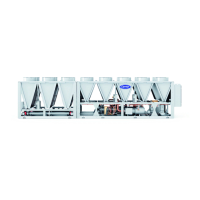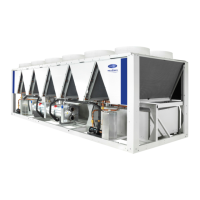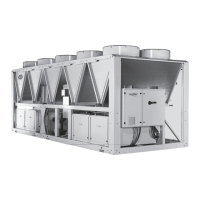44
Operating Limitations
TEMPERATURES — Unit operating temperature limits are
listed in the table below.
LEGEND
* Lowest allowable ambient temperature for the standard unit to start
and operate is 32 F (0° C). With the inclusion of wind baffles and vari-
able speed fans (field fabricated and installed), the unit is capable to
start as low as 0 F (–17.8 C) and to operate as low as –20 F (–29 C)
ambient temperature.
†For sustained operation, EWT should not exceed 70 F (21.1 C).
**Unit requires brine fluid for operation below this temperature.
Low Ambient Temperature Operation — If unit operating
temperatures below 32 F (0° C) are expected, the following
measures are recommended:
• Consider higher loop volumes, 6 to 10 gallons per nomi-
nal ton.
• Loop freeze protection with glycol is strongly recom-
mended to a minimum of 15° F (8.3° C) below lowest
anticipated ambient temperature.
• Chilled water pump control is required.
• If wind velocity is expected to be greater than 5 mph
(8 km/h) wind baffles and brackets must be field-fabri-
cated and installed. See the 30XV Installation Instruc-
tions for more information.
VOLTAGE
Main Power Supply
— Minimum and maximum acceptable
supply voltages are listed in the Installation Instructions.
Unbalanced 3-Phase Supply Voltage
— Never operate a
motor where a phase imbalance between phases is greater than
2%.
To determine percent voltage imbalance:
The maximum voltage deviation is the largest difference
between a voltage measurement across 2 legs and the average
across all 3 legs.
Example: Supply voltage is 240-3-60.
AB = 243v
BC = 236v
AC = 238v
1. Determine average voltage:
2. Determine maximum deviation from average voltage:
(AB) 243 – 239 = 4 v
(BC) 239 – 236 = 3 v
(AC) 239 – 238 = 1 v
Maximum deviation is 4 v.
3. Determine percent voltage imbalance:
= 1.7%
This voltage imbalance is satisfactory as it is below the
maximum allowable of 2%.
MINIMUM FLUID LOOP VOLUME — To obtain proper
temperature control, loop fluid volume must be at least 3 gal-
lons per ton (3.25 L per kW) of chiller nominal capacity for air
conditioning and at least 6 gallons per ton (6.5 L per kW) for
process applications or systems that must operate at low ambi-
ent temperatures (below 32 F [0° C]). Refer to application in-
formation in Product Data literature for details.
FLOW RATE REQUIREMENTS — Standard chillers
should be applied with nominal flow rates within those listed in
the Minimum and Maximum Evaporator Flow Rates table.
Higher or lower flow rates are permissible to obtain lower or
higher temperature rises. Minimum flow rates must be exceed-
ed to assure turbulent flow and proper heat transfer in the evap-
orator. See Table 30. See Fig. 38 and 39 for evaporator pressure
drop curves.
Consult application data section in the Product Data lit-
erature and job design requirements to determine flow rate
requirements for a particular installation.
TEMPERATURE F C
Maximum Ambient Temperature 125 52
Minimum Ambient Temperature* 32 0
Maximum Evaporator EWT† 95 35
Maximum Evaporator LWT 60 15
Minimum Evaporator LWT 38** 3.3
EWT — Entering Fluid (Water) Temperature
LWT — Leaving Fluid (Water) Temperature
% Voltage Imbalance = 100 x
max voltage deviation from
avg voltage
average voltage
Average voltage =
243+236+238
3
=
717
3
= 239
% Voltage Imbalance = 100 x
4
239
IMPORTANT: If the supply voltage phase imbal-
ance is more than 2%, contact the local electric
utility company immediately. Do not operate unit
until imbalance condition is corrected.
CAUTION
Operation below minimum flow rate could generate
alarms, which could result in damage to the evaporator.

